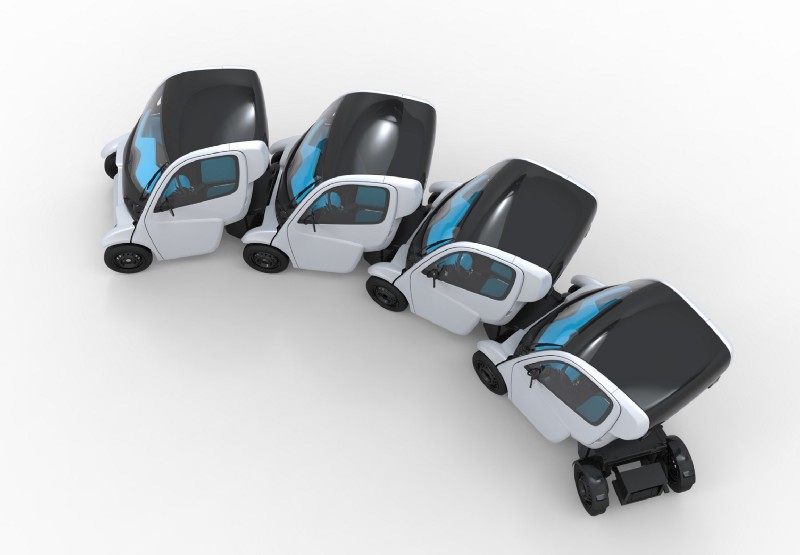The promise is that we will soon be able to smoothly move from our current destination to anywhere we want to go in a city, whether it be by bicycle, scooter, bus, train, metro, a ride-hailing or car-sharing service or even a flying taxi, or a combination of any of these services.
Autonomous cars will transact and communicate with their passengers, each other, and countless other Internet of Things (IoT) devices in cities, ranging from electric charging devices to parking lots and toll stations.
And it will all be underpinned by blockchain, a digital ledger technology that looks poised to take urban mobility to the next level.
Autonomy, an urban mobility conference in Paris taking place October 19 and 20, will showcase these types of present-day and future mobility services.
A representative from a European ESPRIT research project is scheduled to talk about work on electric cars for inner-city and suburban use that can be connected in a Lego-like train formation and charged either together or separately. (See the picture on page X.)
City bike-sharing services are exploding worldwide, giving rise to new players. Ofa, the operator of a bike-sharing scheme in China involving 10 million bikes, has recently launched services in Milan, Vienna, Valencia, and the London borough of Hackney. It will be present at Autonomy and now says Paris is next on the list.
The French electric utility company Engie, which in March acquired EV-Box, a Netherlands-based electric vehicle charging service provider with over 40,000 charging stations, is launching a new car-sharing service at the conference, an example of how a whole variety of actors — including utilities, car companies and insurance companies — are widening the range of their mobility offerings.
Allianz France will announce at Autonomy that it is expanding an existing offer for drivers of semi-autonomous cars that tracks how well a person drives and communicates the information back to the insurance company. If driver sgets high marks they get a discount on their insurance. The company is announcing on Oct. 19 that it will offer reductions of up to 30% to the driver of any kind of car, because Allianz is now able to track driving patterns through an app that will work on smartphones rather than through special equipment installed in a car, which has been the case to date.
The offer is just the latest in a series of moves made by Allianz to embrace new types of technologies and business models impacting urban mobility. The company has partnered with sharing-economy mobility startups including Drivy, Virtuo, Coup and Cityscoot, a provider of self-service electric scooters.
“There is a reason why we have started talking about mobility. There is a profound transformation going on,” says Delphine Asseraf, who has just been named to head up Allianz France’s focus on mobility. “What will be most important going forward is not to insure a car or a scooter but the movements of our clients.”
Car companies are also adapting their offerings.
Daimler’s mobility services now include the car-sharing company car2go, which gives customers the option of renting a car at any time; mytaxi, a taxi hailing app; and the mobility platform moovel, which offers on-demand access to various services, including booking and payment. It now has some 15 million mobility services customers registered in over 100 cities in Europe, North America and China.
Startups, too, see an opportunity in catering to the demand for new types of mobility. Amber Mobility in the Netherlands is developing a modular, autonomous, customizable electric car designed specifically to be shared. The Dutch bank ABN Amro has signed on as a launching customer. Amber plans to have the self-driving cars on the road in Eindhoven by mid-2018.
TomTom, the Dutch company famous for in-car navigation systems, in July announced it is teaming with Cisco Research to create the next generation of traffic information technology. The research combines Cisco’s data with TomTom’s traffic fusion technology and expertise, supported by Cisco’s Internet of Things platform.
Data is collected via a distributed acoustic-sensing technology, which has the ability to convert a fiber-optic cable into an array of virtual microphones that detect and measure vehicle movements. This data is being merged with TomTom’s pool of car data from over 500 million devices. It is then displayed and analyzed in a TomTom interface specifically designed for the needs of traffic management centers. The goal is to increase the accuracy of real-time traffic services, while reducing the costs of traffic-monitoring infrastructure.
Such services “will be very useful for everyday commutes and even more important tomorrow in an autonomous driving situation,” says Antoine Saucier, managing director for TomTom AutomotiveMobility-as-a-service will require all the different services to link up “and it has to be offered in a smooth way from a user experience.”
Seamless mobility-as-a-service will go far beyond existing concepts of intermodal transportation and routing apps, predicts Open Mobility System (OMOS), a not-for-profit blockchain-based system that is aiming to create new ways of transacting and data sharing among all participating mobility players.
In this new highly interconnected machine economy, bills will be settled automatically, no matter how many different mobility services or transport modes passengers use.
But to work well, seamless mobility-as-a-service will demand significantly more cooperation between companies and industries as well as a new digital infrastructure layer.
The question is whether that future will be centralized and controlled by one or more big commercial players _such as a car company building a closed ecosystem or a Silicon Valley player like Google — or if the kind of open system envisioned by OMOS will take root.
“An open system encourages participants to co-create with one another and thus to leverage the expertise and skills of people and companies from around the globe,” OMOS argues in a position paper. “It does not evolve in the minds of a select few developers within a closed platform ecosystem.”
Cross-industry and cross-company collaboration will not be easy to achieve, since nearly all the big players in the mobility sector are on a path to build proprietary systems that will compete with each other.
The benefits of an open system, argues OMOS, are avoiding lock-in effects and information monopolies; encouraging creative and fair competition within a communal and democratically governed digital transaction infrastructure; allowing a high level of data sovereignty for customers and companies; and ensuring secure, controlled, use-case-specific and real-time data sharing.
The type of open collaborative platform for coordinating mobility-as-a-service that OMOS describes works well on the blockchain.
So do autonomous cars. Blockchain’s architecture is ideally suited to handling the negotiation of payment, who you are, your reputation, the car’s reputation and the contract.
On The Block
Using blockchain, trip charges can be automatically deducted from passengers’ blockchain-enabled digital wallets or charged to their credit cards, with payment instantly flowing to the vehicle owner.
Access and identity tokens and P2P transactions will enable the easy, secure sharing of not only vehicles but infrastructure such as toll roads, recharging stations and parking lots, predicts Carsten Stöcker, a senior manager in the Machine Economy Innovation Program at Innogy, the German utility..
For example, Share & Charge, which was developed by the German startup MotionWerk and bills itself as the first mobility service on blockchain, connects public and private e-charging infrastructure across Europe on a “Decentral Mobility Network” to enable direct, cross-country e-charging.
The service, which launched in May, includes a central charging platform for car owners and charging station operators.
Private charging station owners are able to independently determine the charging methods and the price of their electricity service. Electric vehicle owners can search for the next driver’s station on an interactive map. A transparent and safe payment system based on blockchain is planned.
The blockchain-enabled identity of each user will carry proof of identity, age, insurance coverage and ability to pay, while protecting the anonymity of the passengers and information about their travels, as well as the security of their payment mechanisms.
The smart contracts governing such transactions are based on standard templates that assure accurate, instant collection of taxes and regulatory reporting, wherever the trip takes place.
In the short run, blockchain will allow any vehicle owner to join the transportation market without barriers to entry such as paying a fee and agreeing to the terms of centralized ride-sharing services or paying a bank to process payments.
With blockchain-enabled mobility, all providers and consumers can equally participate in a transportation system, setting the terms, conditions and pricing they choose.
Eventually, the vehicles themselves may become economically independent with their own profit and loss statements, Stöcker says. They’ll make independent decisions based on algorithms and real-time information about everything from demand levels to the prices of repairs and recharging to maximize either the owner’s profit or the good of society.
Over time, ownership models will evolve. By registering vehicles on the blockchain “ownership” and “access” will be tokenized, meaning owners can trade their shares in the vehicles or their rights to use them directly through the blockchain without the involvement of third parties. Some vehicles will continue to be owned by individuals or legal entities.
Others will have multiple owners whose identities and shares in the vehicle can change in real time. Car companies will not necessarily generate sales via car dealers.
They will simply deploy cars in areas where their use can generate an economically viable cash flow, and trade ownership to other parties when algorithms show that would maximize cash flows. Secure, immutable information about the ownership and usage of the vehicle will be stored on the blockchain.
As P2P marketplaces become more mature and consumers become more comfortable with “ownerless” transportations, some vehicles may “own” themselves as economically autonomous entities.
Autonomous vehicles eliminate the cost of human drivers, while blockchain eliminates the middlemen like Uber and Lyft that match customers with rides, charge a transaction fee and set terms and conditions, says Stöcker.
OMOS says it can use blockchain to offer all partners a base on which to build business applications that give customers the seamless mobility-as-a-service experience they are seeking.
Its advancement depends on solving a few technological problems but also on a shift in mindset around co-operation.
“In the media world we painfully experience the repercussions of what happens when Internet services establish quasi-monopolies,” says Jochen Renz, a managing partner at New Mobility Consulting and a scheduled speaker at Autonomy. “Mobility is too important to have powerful platforms control it and dictate terms. Distributed Ledger Technologies can provide the shared identity mechanism, asset transfer and monetary exchange layer to enable a P2P sharing economy without central intermediaries and provide seamless access to multi-modal transportation. Most importantly, it enables us — the consumer –to stay in control of our data as the new fuel.”







